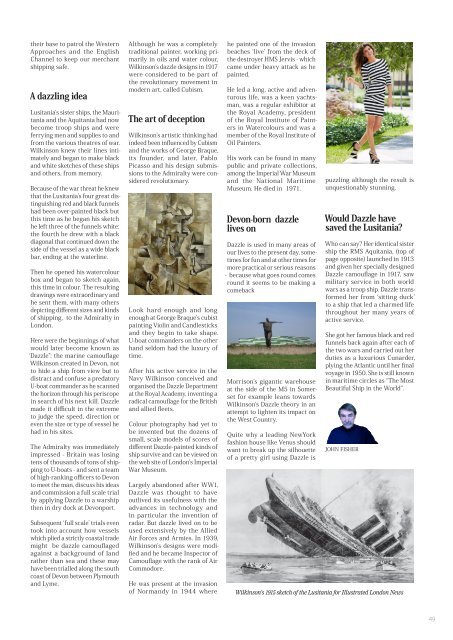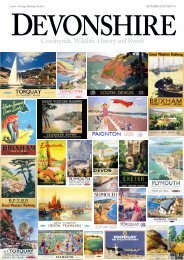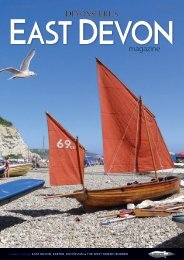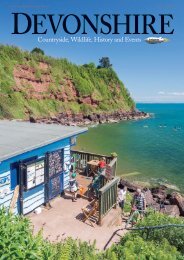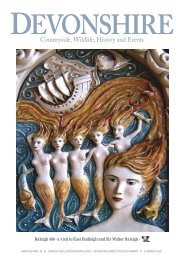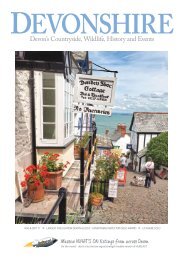Devonshire February March 17
Devon's Countryside, Wildlife, History and Events
Devon's Countryside, Wildlife, History and Events
Create successful ePaper yourself
Turn your PDF publications into a flip-book with our unique Google optimized e-Paper software.
their base to patrol the Western<br />
Approaches and the English<br />
Channel to keep our merchant<br />
shipping safe.<br />
<br />
Lusitania’s sister ships, the Mauritania<br />
and the Aquitania had now<br />
become troop ships and were<br />
ferrying men and supplies to and<br />
from the various theatres of war.<br />
Wilkinson knew their lines intimately<br />
and began to make black<br />
and white sketches of these ships<br />
and others, from memory.<br />
Because of the war threat he knew<br />
that the Lusitania’s four great distinguishing<br />
red and black funnels<br />
had been over-painted black but<br />
this time as he began his sketch<br />
he left three of the funnels white:<br />
the fourth he drew with a black<br />
diagonal that continued down the<br />
side of the vessel as a wide black<br />
bar, ending at the waterline.<br />
Then he opened his watercolour<br />
box and began to sketch again,<br />
this time in colour. The resulting<br />
drawings were extraordinary and<br />
he sent them, with many others<br />
depicting different sizes and kinds<br />
of shipping, to the Admiralty in<br />
London.<br />
Here were the beginnings of what<br />
would later become known as<br />
‘Dazzle”: the marine camouflage<br />
Wilkinson created in Devon, not<br />
to hide a ship from view but to<br />
distract and confuse a predatory<br />
U-boat commander as he scanned<br />
the horizon through his periscope<br />
in search of his next kill. Dazzle<br />
made it difficult in the extreme<br />
to judge the speed, direction or<br />
even the size or type of vessel he<br />
had in his sites.<br />
The Admiralty was immediately<br />
impressed - Britain was losing<br />
tens of thousands of tons of shipping<br />
to U-boats - and sent a team<br />
of high-ranking officers to Devon<br />
to meet the man, discuss his ideas<br />
and commission a full scale trial<br />
by applying Dazzle to a warship<br />
then in dry dock at Devonport.<br />
Subsequent ‘full scale’ trials even<br />
took into account how vessels<br />
which plied a strictly coastal trade<br />
might be dazzle camouflaged<br />
against a background of land<br />
rather than sea and these may<br />
have been trialled along the south<br />
coast of Devon between Plymouth<br />
and Lyme.<br />
Although he was a completely<br />
traditional painter, working primarily<br />
in oils and water colour,<br />
Wilkinson’s dazzle designs in 19<strong>17</strong><br />
were considered to be part of<br />
the revolutionary movement in<br />
modern art, called Cubism.<br />
<br />
Wilkinson’s artistic thinking had<br />
indeed been influenced by Cubism<br />
and the works of George Braque,<br />
its founder, and later, Pablo<br />
Picasso and his design submissions<br />
to the Admiralty were considered<br />
revolutionary.<br />
Look hard enough and long<br />
enough at George Braque’s cubist<br />
painting Violin and Candlesticks<br />
and they begin to take shape.<br />
U-boat commanders on the other<br />
hand seldom had the luxury of<br />
time.<br />
After his active service in the<br />
Navy Wilkinson conceived and<br />
organised the Dazzle Department<br />
at the Royal Academy, inventing a<br />
radical camouflage for the British<br />
and allied fleets.<br />
Colour photography had yet to<br />
be invented but the dozens of<br />
small, scale models of scores of<br />
different Dazzle-painted kinds of<br />
ship survive and can be viewed on<br />
the web site of London’s Imperial<br />
War Museum.<br />
Largely abandoned after WW1,<br />
Dazzle was thought to have<br />
outlived its usefulness with the<br />
advances in technology and<br />
in particular the invention of<br />
radar. But dazzle lived on to be<br />
used extensively by the Allied<br />
Air Forces and Armies. In 1939,<br />
Wilkinson’s designs were modified<br />
and he became Inspector of<br />
Camouflage with the rank of Air<br />
Commodore.<br />
He was present at the invasion<br />
of Normandy in 1944 where<br />
he painted one of the invasion<br />
beaches ‘live’ from the deck of<br />
the destroyer HMS Jervis - which<br />
came under heavy attack as he<br />
painted.<br />
He led a long, active and adventurous<br />
life, was a keen yachtsman,<br />
was a regular exhibitor at<br />
the Royal Academy, president<br />
of the Royal Institute of Painters<br />
in Watercolours and was a<br />
member of the Royal Institute of<br />
Oil Painters.<br />
His work can be found in many<br />
public and private collections,<br />
among the Imperial War Museum<br />
and the National Maritime<br />
Museum. He died in 1971.<br />
<br />
<br />
Dazzle is used in many areas of<br />
our lives to the present day, sometimes<br />
for fun and at other times for<br />
more practical or serious reasons<br />
- because what goes round comes<br />
round it seems to be making a<br />
comeback<br />
Morrison’s gigantic warehouse<br />
at the side of the M5 in Somerset<br />
for example leans towards<br />
Wilkinson’s Dazzle theory in an<br />
attempt to lighten its impact on<br />
the West Country.<br />
Quite why a leading NewYork<br />
fashion house like Venus should<br />
want to break up the silhouette<br />
of a pretty girl using Dazzle is<br />
puzzling although the result is<br />
unquestionably stunning.<br />
<br />
<br />
Who can say? Her identical sister<br />
ship the RMS Aquitania, (top of<br />
page opposite) launched in 1913<br />
and given her specially designed<br />
Dazzle camouflage in 19<strong>17</strong>, saw<br />
military service in both world<br />
wars as a troop ship. Dazzle transformed<br />
her from ‘sitting duck’<br />
to a ship that led a charmed life<br />
throughout her many years of<br />
active service.<br />
She got her famous black and red<br />
funnels back again after each of<br />
the two wars and carried out her<br />
duties as a luxurious Cunarder,<br />
plying the Atlantic until her final<br />
voyage in 1950. She is still known<br />
in maritime circles as “The Most<br />
Beautiful Ship in the World”.<br />
JOHN FISHER<br />
Wilkinson's 1915 sketch of the Lusitania for Illustrated London News<br />
49


